The Louvre Pyramid is one of the most famous landmarks in Paris. The Louvre Glass Pyramid stands in the Napoleon Courtyard, and it opened to the public in 1989. Designed by the Sino-American architect Ieoh Ming Pei as part of the extensive renovation and expansion project for the Louvre Museum, the Louvre Glass Pyramid welcomes today more than 10 million visitors a year.
Former residence of the kings of France, the Louvre Palace became a museum during the French Revolution. Today, it houses a collection of more than 35,000 works spread over 60,000 m2, including masterpieces such as the Mona Lisa, the Venus de Milo, the Raft of the Medusa, Liberty Leading the People… and so many others!
But do you really know about the Louvre Pyramid, one of the most celebrated structures in the city? Discover these 10+ unusual and fun facts about the Louvre Pyramid inside and out!
Are You Planning a Trip to Paris Last Minute?
If you are booking a last-minute trip to Paris, I’ve got you covered! Below are our guides, top tours, hotels, and more:
» Plan: Paris Travel Planner; Paris Arrondissements Guide; Check out the best Paris Metro tickets for tourists
» Book your flight tickets with Omio; book your train tickets with Omio
Book your transfer from the airport to the city with Welcome Pickups.
» Where to Stay: Best Districts to Stay in Paris
- Le Pavillon de la Reine (historical 5-star hotel in Le Marais)
- Hotel La Comtesse (mid-range hotel with Eiffel Tower view from all the rooms!)
- Hotel Ducs de Bourgogne (super central 4-star hotel near the Louvre)
» Top-Rated Paris Tours & Tickets:
- Louvre Museum Skip-the-Line Ticket
- Eiffel Tower Summit Access Ticket
- Seine River Night Cruise
- Château de Versailles and Gardens
- Catacombs Skip-the-line tour with VIP access to restricted areas
Want skip-the-line access at museums & attractions in Paris? Get your hands on a Paris Museum Pass!
» Don’t leave without travel insurance! SafetyWing Essential plan works well for long and short trips (from 5 days up). Can also cover electronics theft through their add-on.
15+ Louvre Pyramid Facts
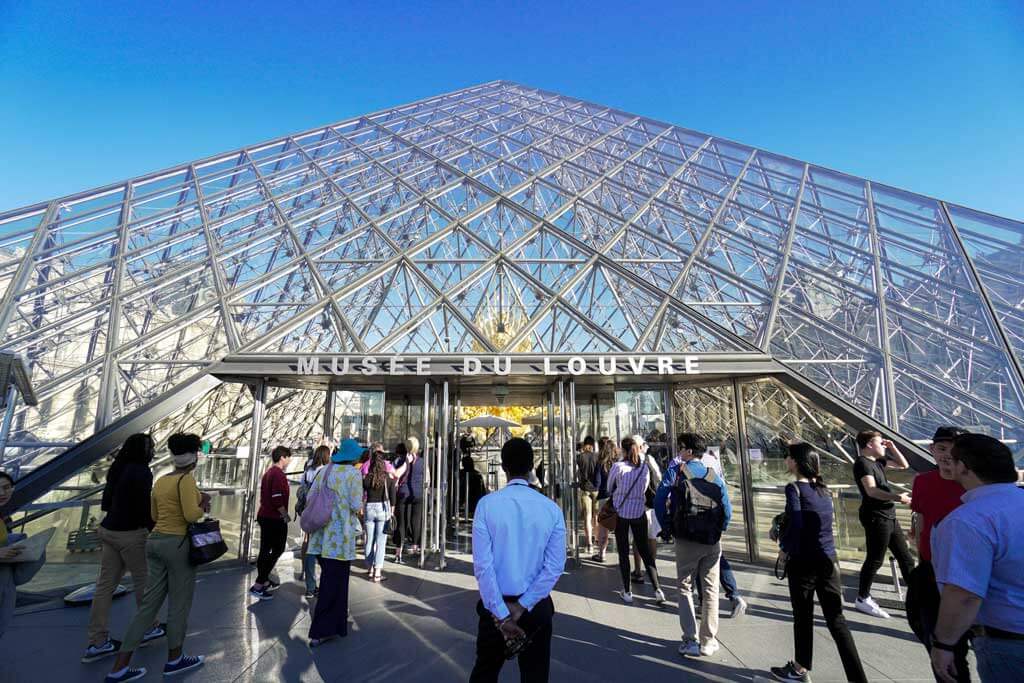
TIP: Check out my quick guide to the Louvre Museum to plan your visit. Click here to buy your skip-the-line Louvre tickets.
1. Louvre Pyramid History
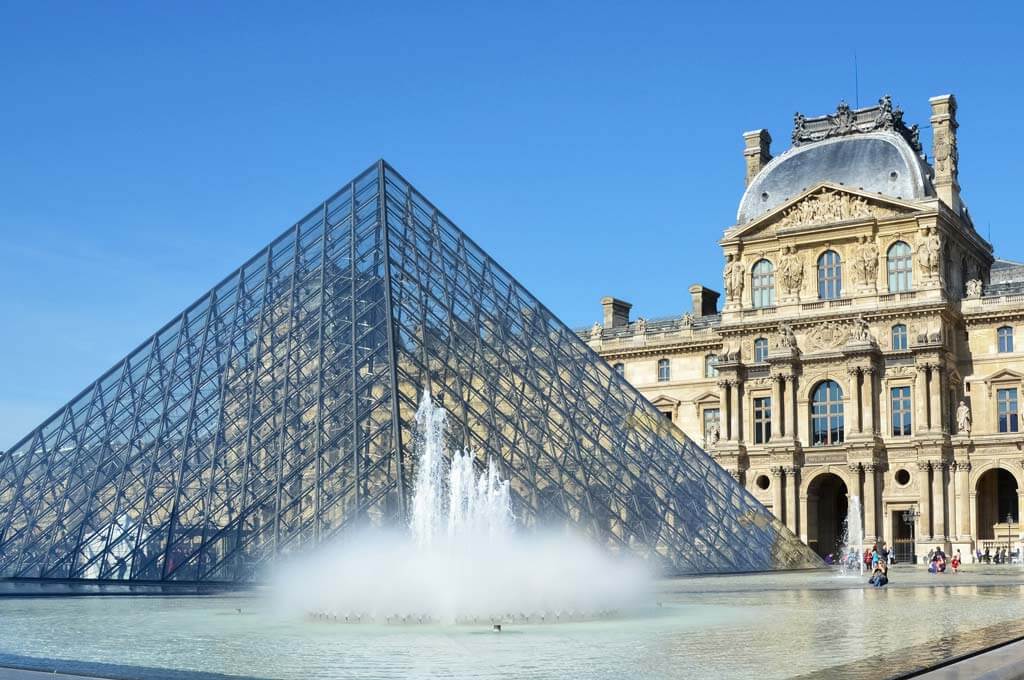
The history of the Louvre Pyramid is fascinating. The Louvre Glass Pyramid was constructed as part of an extensive renovation and expansion project for the Louvre Museum, the “Grand Louvre” project. The project aimed to modernize the museum, make it more accessible to visitors, and increase its exhibition space.
The “Grand Louvre” project was launched in 1981 by François Mitterand, who had just been elected President of the French Republic. The museum would incorporate the Richelieu Wing of the Louvre Palace, which at the time housed the Ministry of Finance.
Paris’ Glass Pyramid was designed to be the Louvre’s new visitor entrance. It needed to complement the surrounding architecture and not overshadow the view of the buildings all around. At the same time, the entrance had to stand out and be easy to find.
When the Grand Louvre project was completed, the exhibition space doubled. The glass-and-metal structure designed by I.M. Pei sits atop the Louvre’s underground, yet light-filled, lobby. It acts as the main entrance and connects the museum’s three pavilions — Denon, Richelieu and Sully.
TIP: Big museum and little time? Check out how to visit the best of the Louvre in 2 hours or less
2. What Does the Louvre Pyramid Represent?
The Louvre Pyramid symbolizes encounter, reconciliation, synthesis, balance, and harmony. It is the entrance to the Louvre Museum and, generally, a gateway to knowledge.
3. The Louvre Glass Pyramid Wasn’t Received Well Initially
When the design was initially presented, the Glass Pyramid “sparked much media controversy and unleashed passions on both aesthetic and technical grounds,” according to a press statement from the Louvre. The structure was straight-up ridiculed by the French media, which called it an “architectural joke.”
90% of Parisians were against the Louvre Pyramid construction, deeming it too radical for the surrounding classic French style. Also, some people didn’t like the fact that the architect wasn’t “French enough” to design such an important monument in the city, right in the middle of the Axe Historique of Paris.
The architect had fully expected controversy in this instance, and he was not surprised when he was attacked. In regards to the choice of a pyramid for the new Louvre entrance, I.M. Pei wrote:
“We experimented with various forms; we even tried a cube or a curved, hemispheric shape. But, if you look at the silhouette of the Louvre, there is no curve, so we had to exclude curves. I concluded that the pyramid was the only shape that was acceptable. It is the most appropriate form.”
This is one of the Louvre Pyramid facts that shouldn’t surprise our readers: a similar rejection by the Parisians happened at the inauguration of the Eiffel Tower, designed for the Paris World Fair of 1889. Today, however, the Tower is recognized as the symbol of Paris and France, and climbing to the top of the Eiffel Tower is one of the best things to do in Paris.
4. The Idea of a Pyramid at the Louvre is Much Older
However, the idea of a pyramid at the Louvre dates back to the 19th century! A pyramid in the Napoleon courtyard was initially proposed for the celebrations of the French Revolution, in particular for the centenary. Architect Louis Ernest Lheureux proposed a cyclopean pyramid project in neo-Aztec style).
You can also find this idea in the small booklet, “Memoirs on two great obligations to be fulfilled by the French”, written by Balzac and published in 1809. One of these obligations was to erect, in the courtyard of the Louvre, a pyramid which would be a national monument of recognition to the Emperor (Napoleon).
It is possible that the architect Ieoh Ming Pei was aware of this proposal when he chose the pyramid shape for the Louvre.
TIP: The Louvre is located in Paris 1, the most central Arrondissement of Paris, near the Tuileries Garden, the Palais Royal, and the Seine River. With such a privileged position, hotels near the Louvre Museum are highly requested, so book your room well in advance!
5. There are Satanist Theories About Paris’ Glass Pyramid
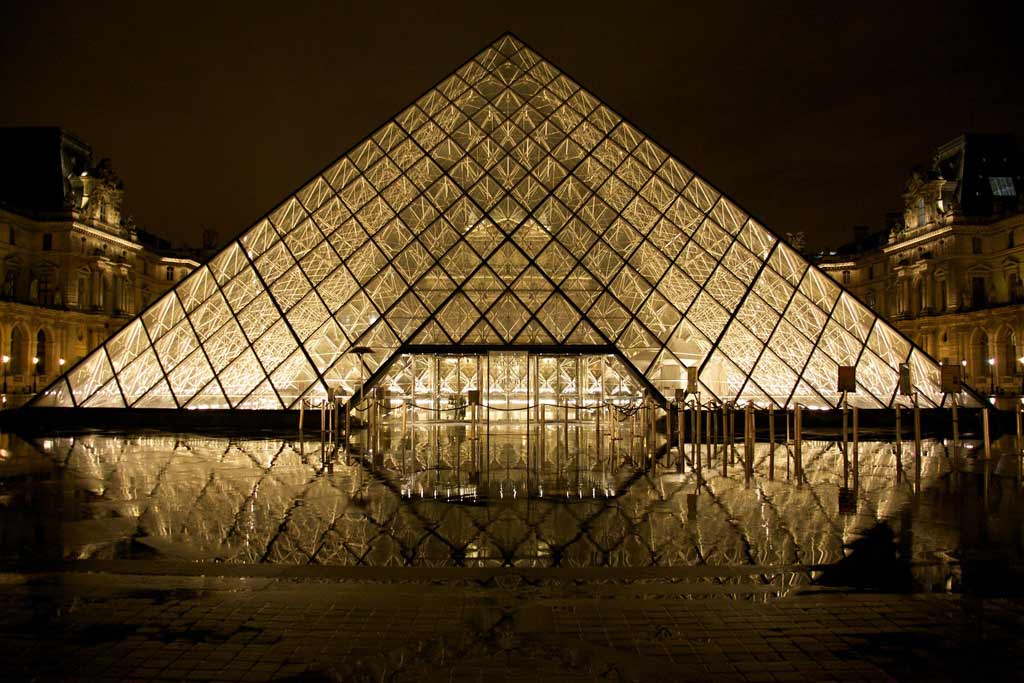
The urban legend has long preached the existence of 666 (the devil’s number!) glass panels on the Louvre Pyramid. Even recently, in the Da Vinci Code by Dan Brown, we find an allusion to these obscure theories.
The most tenacious myth about the Glass Pyramid in Paris is that it is the work of the Devil! But these rumours are, in reality, only rumours: there are exactly 603 diamonds and 70 triangles for a total of 673 glass panels.
6. The Louvre Pyramid is Based on the Cheops Pyramid
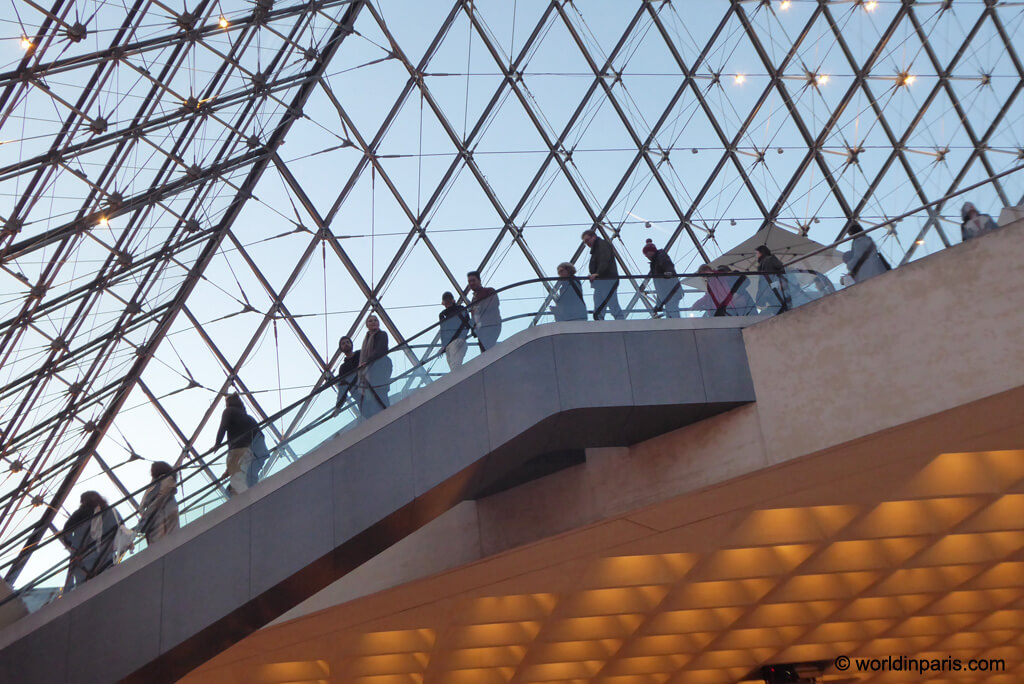
It is also said that the Louvre Pyramid is based on the proportions of the Cheops Pyramid in Egypt. This is totally true! With a square base of 35.24 meters on each side and 21.64 meters high, the Louvre Glass Pyramid is indeed a reduction of the most famous pyramid in the world.
7. Louvre Pyramid Dimensions and Numbers
Technically, the Louvre Pyramid occupies an area at its base of 1,000 m2 and rises 21.65 meters above the ground. It is a self-supporting structure with no pillars and is made up of 95 tons of steel, 105 tons of aluminium frames and 673 glass lozenges. The Pyramid has the same proportions as the Cheops Pyramid in Egypt, and the same slope was also given, of 51 degrees.
As soon as the excavation works started, workers discovered remains of Medieval Paris, like the parade helmet of King Charles VI. This construction project will last 10 years! – estimated the architects. To keep the schedule, the preventive archaeology works were completed in the time record of one year.
How long did it take to build the Louvre Pyramid? The Louvre’s Glass Pyramid was inaugurated on 4 March 1989. Construction took four years and cost two billion Francs.
8. New Glass Was Developed for the Louvre Pyramid Construction
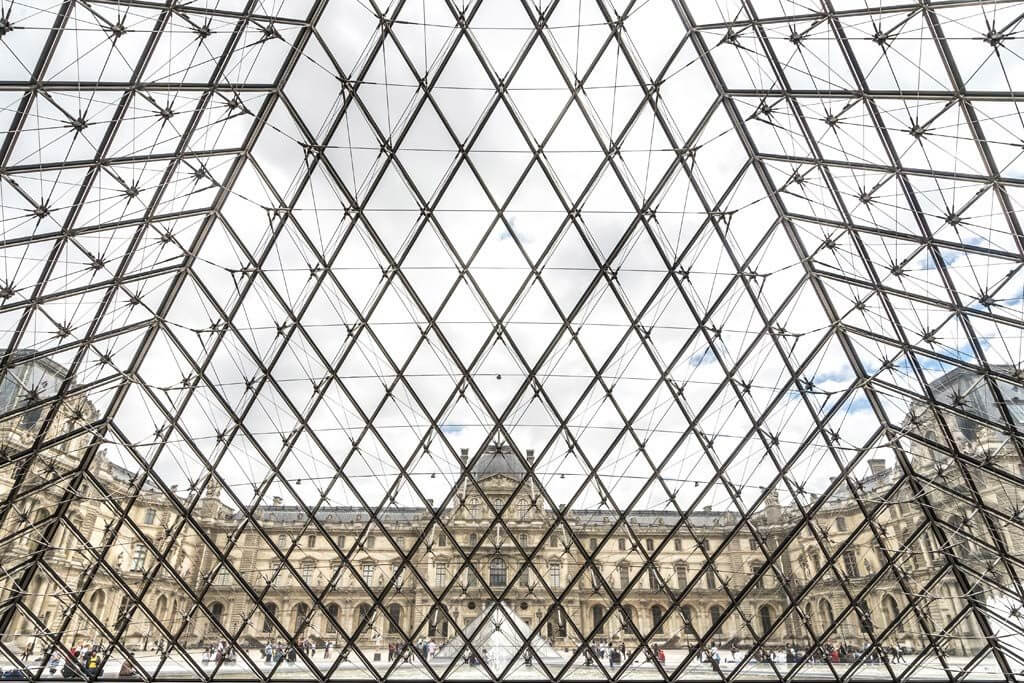
I.M. Pei insisted on total transparency in the Glass Pyramid to not obstruct the view of the wonderful Louvre building. Finding a clear glass presented a serious challenge because glass has a faint bluish or greenish tint. So he enlisted the French manufacturing company Saint-Gobain to create a new glass specifically for the project.
Months of exhaustive research went into developing this 21.5-millimetre extra-clear laminated glass called “Verre Diamant,” which has exceptional mechanical properties and high optical quality. It took about two years to get it right, and removing the iron oxides (to avoid any green reflection) required the company to construct a special furnace.
There are 1,800 square meters of glass in the pyramid — 675 “lozenges” (the rhombus-shaped glass segments we associate with the Pyramid) — and 118 triangles. These rest on a structure composed of 6,000 metal bars, bringing the total weight of the Glass Pyramid in Paris to 200 tons.
Just in case any glass pieces ever break, Saint-Gobain made enough to build two glass pyramids! After more than 30 years, however, no repairs have yet been needed — Where do they store such an incredible amount of Verre Diamants, by the way?!
9. The Pyramid’s Design Aligns with French Tradition
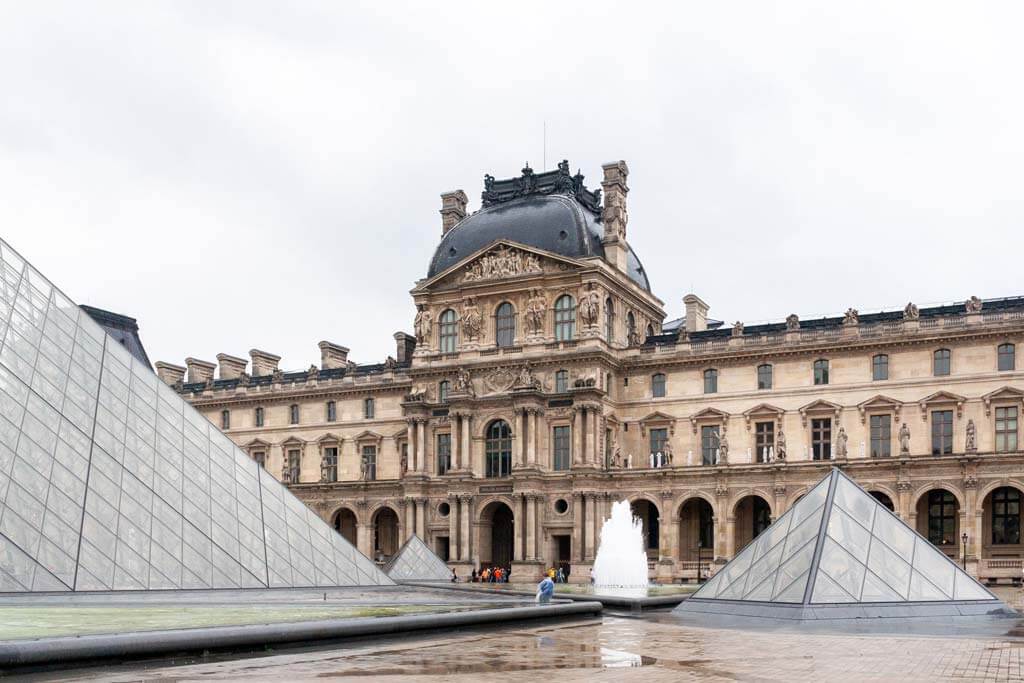
Despite its seeming contrast with the French Renaissance style of the Louvre Museum, the Glass Pyramid keeps with some French architectural traditions.
In fact, when the Louvre Pyramid opened in 1989, The New York Times remarked that it “communicated” with existing monuments of Paris and that the country’s architectural history was “laden with references” to architects like these, who “relied heavily on blunt geometric forms, including pyramids.”
Indeed, French Neoclassical architects of the late 1700s, such as Boullée, Lequeu and Ledoux, experimented with pyramidal forms deployed as monuments, cenotaphs or other programs.
And, of course, just a short walk from the Louvre, the 3,300-year-old Egyptian Obelisk brought from the Luxor Temple in 1833, is on the same line as Paris’ Glass Pyramid. The two monuments complement each other on the city’s landscape.
10. The Thinker at the Louvre Pyramid Inside

The original project planned to erect a statue on the central pillar at the heart of the Pyramid. For this special place, Rodin’s The Thinker was suggested.
A test made with a plaster replica showed that The Thinker looked perfect from the outside, but when seen from below in the lobby, It seemed to be sitting on a pot! Because of this scatological aspect, the statue was not installed, and no replacement solution was found.
11. What Fascinating Feature Lies Beneath the Louvre’s Glass Pyramid, Harkening Back to its Medieval Origins?

The Louvre Pyramid inside includes a vast underground space that would connect several wings of the museum and provide additional exhibition space.
As you step inside the Louvre Pyramid, a large open area with staircases leads down to several levels below ground level. The space is filled with natural light from skylights in the Glass Pyramid overhead.
In this space, we can also see a hidden moat with a section of Charles V’s enclosure, medieval walls which were built in the XIVth century that were destroyed and filled in under Louis XIII between 1624 and 1634.
12. The Louvre Glass Pyramid is not Alone
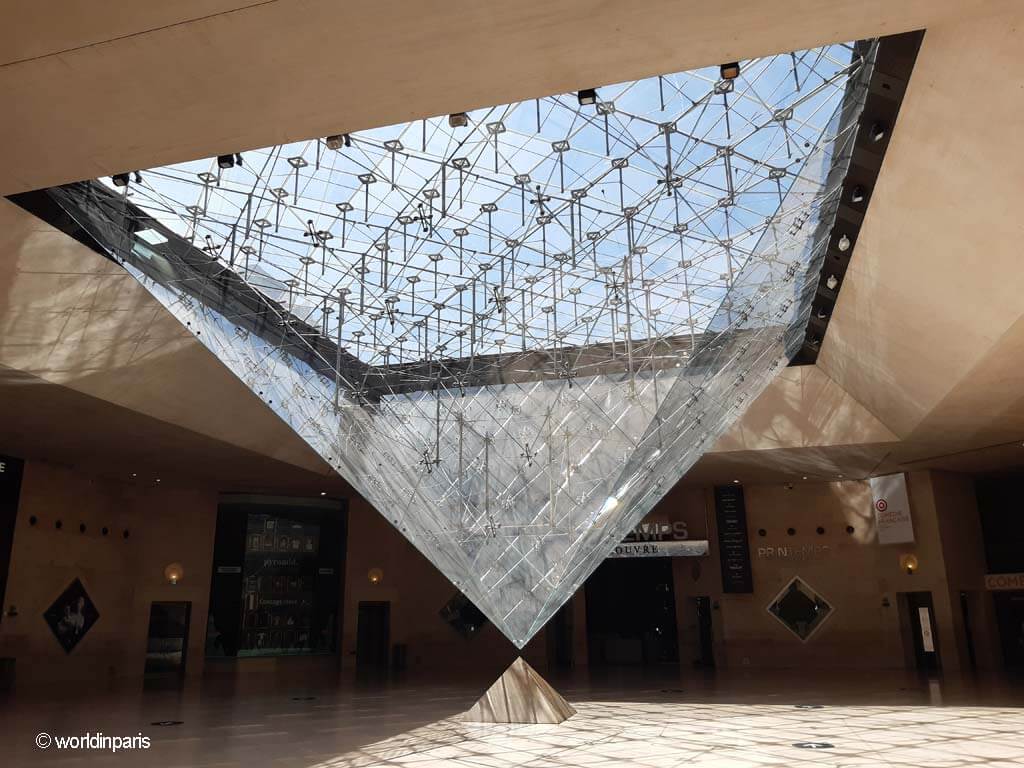
The Louvre Pyramid is surrounded by three much smaller replicas and a fifth pyramid, this one inverted, built under the Carrousel du Louvre.
The three small pyramids represent the Louvre’s three wings: Richelieu, Sully, and Denon.
The Inverted Pyramid illuminates one of the other three entrances to the Louvre. It was completed in 1993, after the other pyramids. From the top, the upside-down pyramid looks like a glass plate.
There are other lesser-known pyramids in Paris: small pyramids in a couple of tombs at Père Lachaise Cemetery (e.g. the Pyramid of Jean-Louis Sacchet), the metro station Pyramides, Rue des Pyramides, and Place des Pyramides in (Paris 1), dominated by the statue of Jeanne d’Arc.
13. Cleaning Paris’ Glass Pyramid Is a Monumental Task
One of the most curious facts about the Louvre Pyramid is its cleaning. When the Pyramid was still new, several attempts to clean the glass failed because of how it was inclined.
In the early days, mountaineers were hired to scale the Louvre Pyramid and clean the glass. In the 1990s, a robot was designed to do the job. Then, in 2002, Seattle company Advanced Robotic Vehicles developed a new model, a “double breadbox-sized robot.” Manoeuvred by remote control, the robot climbs the Louvre Glass Pyramid on tracks and is secured to the glass via suction cups. It boasts a squeegee and rotating brush.
However, the cleaning task is not entirely left to the robot. For example, the water features near the Pyramid deposit a mist loaded with tartar on the glass, and it’s necessary to descale the glass from time to time. For this, ropers are still used to repair the joints.
14. The Louvre Pyramid Brought an Increase in Tourism

The Louvre Pyramid brought notoriety to the museum. Once the Pyramid was unveiled, people began to embrace the geometric marvel. The Pyramid helped make the Louvre the most visited museum in the world. Since its creation, the number of annual visitors to the Louvre Museum has increased from 3 to 10 million!
Overall very popular with visitors today, the Glass Pyramid is the Louvre’s third most popular work, only after the Mona Lisa and the Venus of Milo. The Louvre Pyramid is also the second most visited location after the Eiffel Tower.
The Louvre is also popular with families in Paris with kids. Check out this Louvre Museum guided tour, which is specially designed for families, and this fun Louvre Treasure Hunt.
15. The Louvre Museum is Too Big for the Pyramid Now
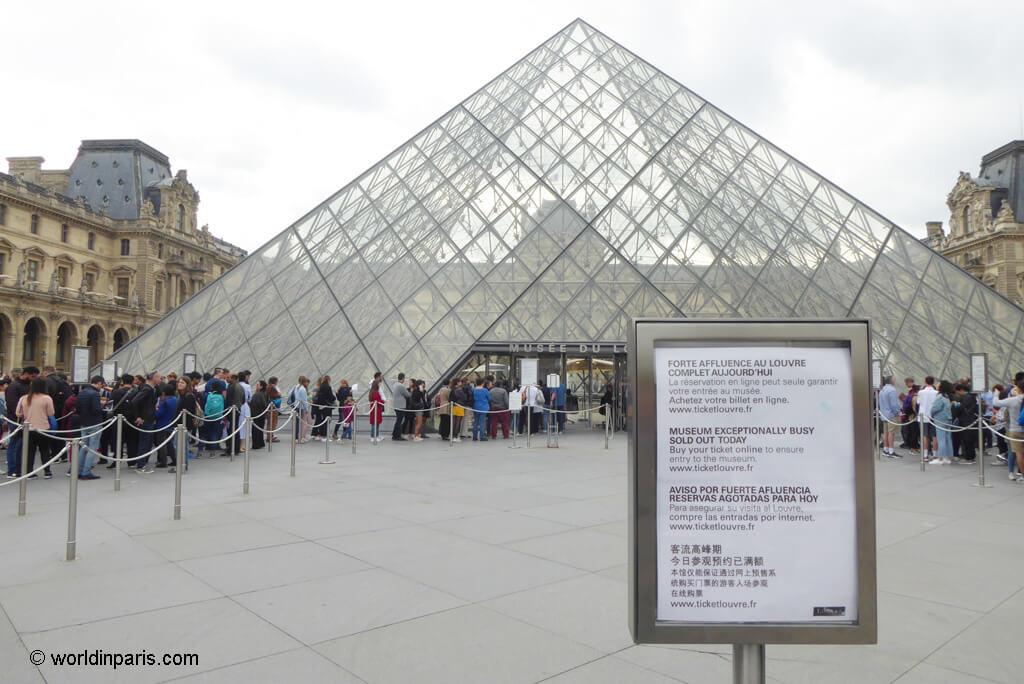
One of the fun facts about the Louvre Pyramid is that it actually became way too small to serve as a proper entrance for the largest museum in the world!
Indeed, the Louvre Glass Pyramid was originally constructed for a museum that would welcome about 4 to 5 million visitors a year. By 2014, this number had already doubled, and at the time of writing this post, this number had nearly tripled!
Luckily, measures were taken, and between 2014 and 2017, a renovation project was done to expand the capacity.
TIP: Check how to skip the longest lines at the Louvre Museum
16. A Vital Part of Paris’ Renowned Cityscape
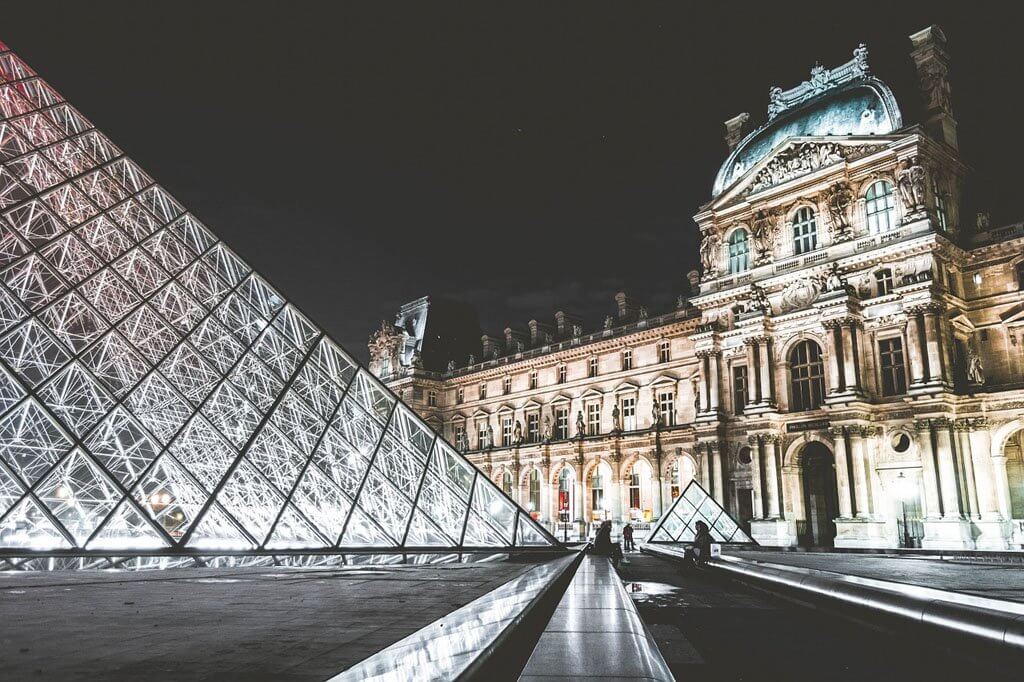
Thirty years after it was unveiled, the Louvre Pyramid in Paris stands in front of the world’s most visited museum, and despite its relative youth, it has become a vital part of Paris’ renowned cityscape, vying with the Eiffel Tower and the Arc de Triomphe for the title of Paris’ most recognizable landmark.
This Glass Pyramid has also been featured in several movies and has been written about in novels.
The Louvre and its Glass Pyramid are part of the best views of Paris. The Louvre Glass Pyramid and its three little sisters also offer exceptional subject matter for photographers and Instagrammers, especially at night when they are illuminated. Book a Paris photoshoot with a professional photographer by the Glass Pyramid at the Louvre and other landmarks for the best souvenir from Paris!
And there you have it: some fun facts about the Louvre Pyramid inside and out! Now, you only need to head to the Louvre to visit this iconic landmark.

